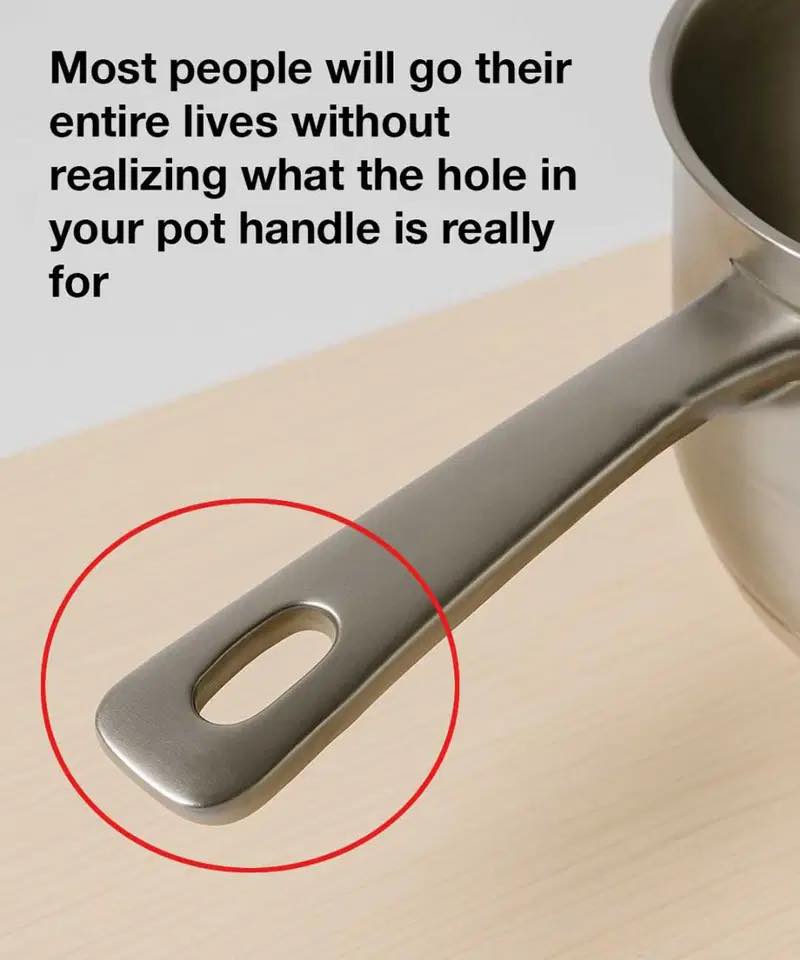In the world of kitchen tools and cookware, it’s easy to overlook the small details—especially when they seem insignificant at first glance. But as it turns out, even the tiniest design choices can have surprisingly useful purposes. Take the hole in the handle of pots and pans, for example.

Most of us have probably seen it a thousand times without thinking twice about it. Some people might assume it’s just a random feature, a quirk of design, or only useful for hanging the pot on a hook. But the truth is, this little hole is far more versatile than it appears and can be a real game-changer in the kitchen once you know what it’s actually meant to do. Let’s explore the hidden potential of this often-overlooked feature and clear up some of the common myths surrounding it. First off, yes—it’s true that the most obvious use of the hole is for hanging your cookware.
This is especially helpful in kitchens with limited storage or cabinet space. By hanging your pots and pans on a rack or wall hook, you free up precious room in drawers and cupboards, and your most-used items are always within reach. But to assume that’s the only function of the handle hole would be missing out on some seriously handy uses. One of the smartest—and most underrated—uses of the pot handle hole is as a spoon holder.
When you’re cooking and need somewhere to rest your stirring spoon, instead of setting it on the counter and dealing with the inevitable drips and mess, you can simply slide the spoon handle through the hole. This keeps the spoon elevated and positioned above the pot, allowing any drips to fall right back into the food instead of onto your countertop. It’s a small trick, but one that can make cleanup so much easier and keep your workspace more organized. Another lesser-known use is for pouring. If you’ve ever tried to transfer hot soup or sauce from a pot to a smaller container, you know how tricky it can be to control the flow, especially with wide-rimmed pots. By inserting a wooden spoon or similar utensil through the hole, you can create a makeshift spout that helps guide the liquid more precisely and minimizes the risk of spills or splashes.
It’s a simple fix that can save a lot of frustration when dealing with hot liquids. The hole can also serve as a makeshift measuring guide. While it’s not as accurate as a measuring cup, it can be helpful when you need a rough estimate. For instance, some people use the hole to measure out a single serving of spaghetti by bunching the uncooked noodles and seeing if they fit through. It’s not perfect, but when you’re cooking a casual meal and don’t want to fuss with extra tools, it works surprisingly well. Additionally, the hole can improve your grip and handling of the pot, especially if you’re using oven mitts or a towel. By slipping your finger or thumb through the hole, you get extra leverage and stability, making it easier to lift, tilt, or stir the pot safely. This can be particularly useful when you’re moving a heavy pot full of food or liquid from the stove to the table or sink. What might seem like a purely decorative or insignificant feature is actually a thoughtfully engineered part of your cookware. It’s designed to make cooking more efficient, organized, and safe, all without taking up any extra space. Once you start using the pot handle hole to its full potential, you’ll wonder how you ever cooked without it. So the next time you’re in the kitchen and reach for your favorite pot, take a second look at that little hole in the handle—it’s doing more for you than you ever realized. Whether it’s holding your spoon, guiding your pour, helping you measure, or giving you a better grip, that tiny feature proves that smart design really is in the details.





